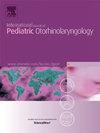Dysfunction of vestibulo-ocular reflex in infants and toddlers
IF 1.2
4区 医学
Q3 OTORHINOLARYNGOLOGY
International journal of pediatric otorhinolaryngology
Pub Date : 2025-02-03
DOI:10.1016/j.ijporl.2025.112247
引用次数: 0
Abstract
Objective
To investigate the occurrence of functional loss in the vestibulo-ocular reflex (VOR) among young children with vestibular/balance concerns and/or hearing loss.
Materials and methods
Retrospective review of 320 children, aged 3 years or under, who underwent rotary chair testing in our pediatric vestibular program. Demographic data, medical diagnosis/findings, and vestibular testing results were documented. Rotary chair outcome was used to determine the functional status of the VOR.
Results
The mean age of these children, 165 girls and 155 boys, was 1.9 years (SD = 0.9). Among these 320 children, 158 patients (49 %) had abnormal VOR findings. There were 40 cases in which video goggles could be properly fitted for recording VOR responses and 28 patients (70 %) had abnormal findings. Observational camera was used in the other 280 patients and 130 of them (46 %) had abnormal VOR findings. Probable causes of abnormal VOR included inner ear malformations, infectious diseases, neurologic involvements and genetic conditions, etc.
Conclusions
Dysfunction of VOR is significant in young children with vestibular/balance concerns and/or hearing loss. While video goggles are ideal for recording VOR responses in the rotary chair, the observational camera approach is effective for younger children who cannot wear video goggles. The outcomes of rotary chair testing can help clinicians to identify possible vestibular pathologies and recommend proper management.
婴幼儿前庭-眼反射功能障碍
目的探讨前庭/平衡问题和/或听力损失幼儿前庭-眼反射(VOR)功能丧失的发生情况。材料和方法回顾性分析320名3岁或以下儿童,在我们的儿科前庭项目中接受了旋转椅测试。记录了人口统计数据、医学诊断/发现和前庭测试结果。扶轮椅结果被用来确定VOR的功能状态。结果女孩165例,男孩155例,平均年龄1.9岁(SD = 0.9)。在这320例患儿中,158例(49%)有异常的VOR结果。有40例视频护目镜可以正确地记录VOR反应,28例(70%)有异常发现。另外280例患者使用观察相机,其中130例(46%)有异常的VOR结果。可能导致VOR异常的原因包括内耳畸形、感染性疾病、神经系统受累和遗传因素等。结论在前庭/平衡问题和/或听力损失的幼儿中,VOR功能障碍很重要。虽然视频护目镜是理想的记录VOR响应在旋转椅上,观察相机的方法是有效的年龄较小的儿童谁不能戴视频护目镜。旋转椅测试的结果可以帮助临床医生识别可能的前庭病变,并建议适当的管理。
本文章由计算机程序翻译,如有差异,请以英文原文为准。
求助全文
约1分钟内获得全文
求助全文
来源期刊
CiteScore
3.20
自引率
6.70%
发文量
276
审稿时长
62 days
期刊介绍:
The purpose of the International Journal of Pediatric Otorhinolaryngology is to concentrate and disseminate information concerning prevention, cure and care of otorhinolaryngological disorders in infants and children due to developmental, degenerative, infectious, neoplastic, traumatic, social, psychiatric and economic causes. The Journal provides a medium for clinical and basic contributions in all of the areas of pediatric otorhinolaryngology. This includes medical and surgical otology, bronchoesophagology, laryngology, rhinology, diseases of the head and neck, and disorders of communication, including voice, speech and language disorders.

 求助内容:
求助内容: 应助结果提醒方式:
应助结果提醒方式:


